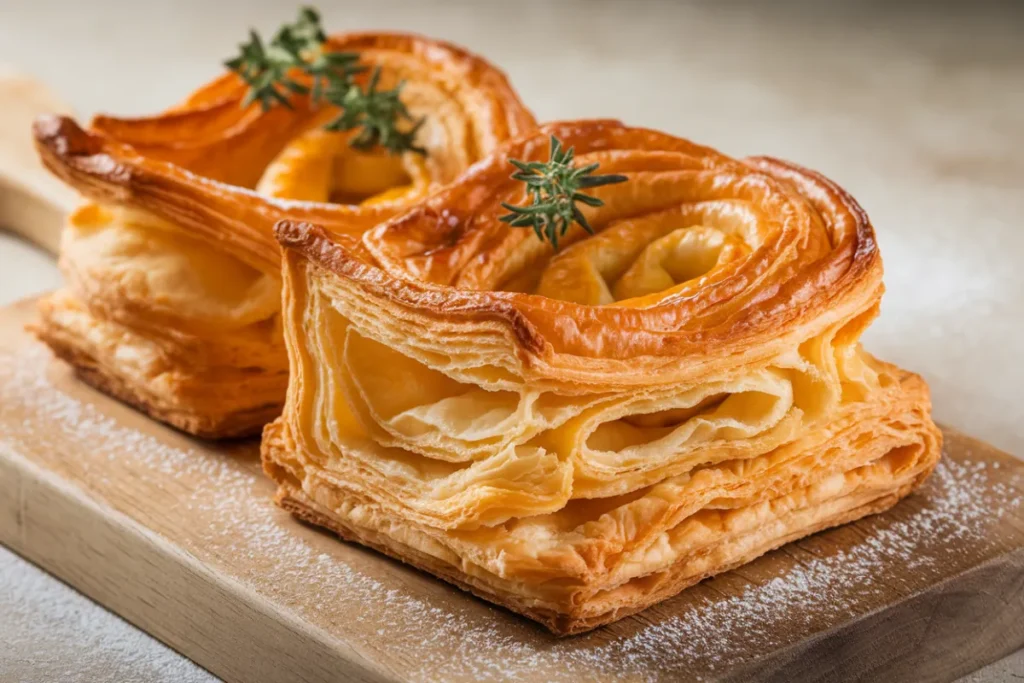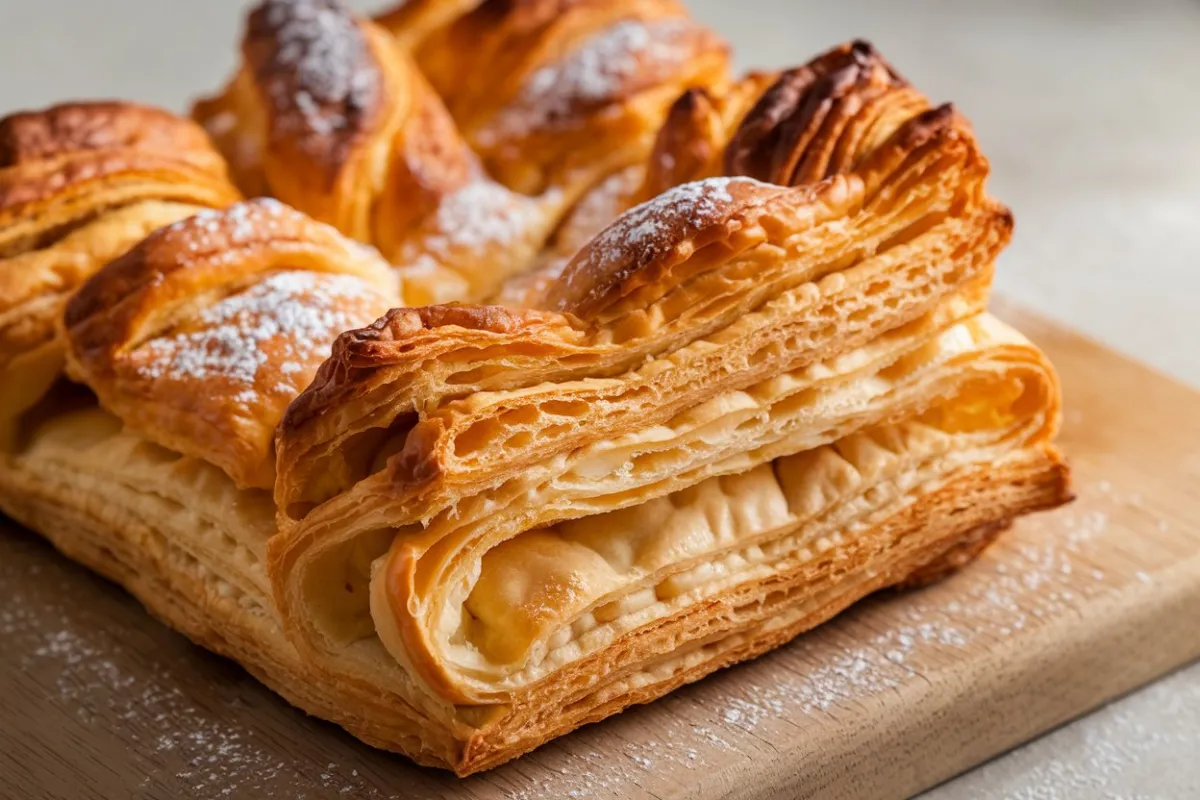If you’re a baking enthusiast or even a beginner, puff pastry recipes are an essential part of your kitchen toolkit. Known for its light, flaky layers, puff pastry is versatile enough to be used in both sweet and savory dishes. Whether you’re creating elegant desserts or comforting main courses, puff pastry can elevate your dishes with its texture and rich flavor. In this guide, we’ll dive into everything you need to know about puff pastry, from making it at home to trying out various recipes that will impress any crowd.
What is Puff Pastry?
Puff pastry is a type of dough that consists of multiple layers of butter and dough. As it bakes, the butter melts and releases steam, causing the dough to puff up and create those signature flaky layers.
- Characteristics: Light, flaky, and buttery.
- Common Uses: Puff pastry is used in a wide range of dishes, from sweet pastries like turnovers to savory items like chicken pot pie.
- Difference from Other Pastries: Unlike other pastries, puff pastry doesn’t rely on chemical leaveners like baking powder or yeast. Instead, the layering of butter and dough creates its rise.
Types of Puff Pastry Recipes
Understanding the different types of puff pastry available can help you choose the right one for your recipe:
- Store-Bought Puff Pastry: This is the most convenient option and is available in the frozen section of most grocery stores. It’s perfect for quick recipes and comes pre-rolled for easy use.
- Homemade Puff Pastry: Making puff pastry from scratch is more time-consuming but allows you to control the quality of ingredients. The flavor and texture of homemade puff pastry are often superior to store-bought versions.
- All-Butter Puff Pastry: This type of puff pastry is made exclusively with butter, providing a richer flavor and flakier texture. It’s ideal for recipes where the buttery taste is a key component.
- Frozen vs. Fresh Puff Pastry: Frozen puff pastry is convenient and can be kept on hand for quick meals. Fresh puff pastry offers the best texture but requires more planning and preparation.
How to Make Homemade Puff Pastry Recipes
Making puff pastry from scratch might seem daunting, but with the right technique, it can be a rewarding process. Here’s how you can make your own puff pastry at home:
Ingredients:
- 2 1/2 cups of all-purpose flour
- 1 cup of cold unsalted butter, cut into small cubes
- 1/2 teaspoon of salt
- 3/4 cup of cold water
Instructions:
- Mix Dry Ingredients: In a large bowl, combine the flour and salt.
- Incorporate Butter: Add the cold butter cubes to the flour mixture. Use a pastry cutter or your hands to cut the butter into the flour until the mixture resembles coarse crumbs.
- Add Water: Gradually pour in cold water, mixing until a rough dough forms. Be careful not to overmix.
- Roll and Fold: On a lightly floured surface, roll the dough into a rectangle. Fold the dough into thirds, like a letter. Rotate the dough 90 degrees and repeat the rolling and folding process five more times. This creates the layers that make puff pastry flaky.
- Chill the Dough: Wrap the dough in plastic wrap and refrigerate for at least 1 hour before using.
Homemade puff pastry is a labor of love, but the results are worth the effort. It’s perfect for both sweet and savory puff pastry recipes.
Preparing Puff Pastry for Recipes
Properly preparing your puff pastry is key to achieving those beautiful, flaky layers in your recipes:
- Thawing Store-Bought Puff Pastry: If using frozen puff pastry, transfer it to the refrigerator and let it thaw slowly for a few hours. Avoid thawing puff pastry at room temperature, as it can become too soft and sticky.
- Rolling Puff Pastry: Use a lightly floured surface to roll out the puff pastry. Gently roll from the center outward to maintain the even thickness of the dough. Avoid pressing too hard, as this can compress the layers.
- Cutting Puff Pastry: Use a sharp knife or pizza cutter for clean, precise cuts. Dull tools can squish the layers together, preventing the pastry from puffing up properly.
- Shaping Puff Pastry: Depending on your recipe, you may need to fold, twist, or roll the puff pastry into specific shapes. Be gentle when shaping to avoid disrupting the layers.
By following these preparation tips, your puff pastry will be ready for any recipe, whether you’re making a sweet dessert or a savory dish.
Sweet Puff Pastry Recipes
If you have a sweet tooth, sweet puff pastry recipes are a must-try. These desserts are not only delicious but also visually impressive:
- Apple Turnovers: Filled with cinnamon-spiced apples and baked until golden brown, apple turnovers are a classic puff pastry dessert. Serve them warm with a scoop of vanilla ice cream.
- Chocolate Croissants: A quick and easy version of the French classic, these croissants are filled with rich chocolate and baked until flaky and golden.
- Cream-Filled Pastries: Light and airy puff pastry filled with sweet cream, these pastries are perfect for special occasions or indulgent breakfasts.
- Berry Tartlets: These mini tarts are filled with fresh berries and a hint of lemon zest. They’re a refreshing and light dessert option.
Sweet puff pastry recipes like these are perfect for impressing guests or simply treating yourself to something special.
Savory Puff Pastry Recipes
On the savory side, puff pastry recipes can be used to create appetizers, main courses, and snacks that are both satisfying and flavorful:
- Cheese and Herb Twists: Puff pastry is twisted with a mixture of cheese and herbs, creating a savory snack or appetizer that’s perfect for parties.
- Chicken Pot Pie: Puff pastry serves as the golden, flaky crust for this comforting dish. The creamy chicken filling is a perfect match for the light pastry.
- Sausage Rolls: Puff pastry is wrapped around seasoned sausage, making these rolls a favorite for picnics and parties. They’re easy to make and always a hit.
- Spinach and Feta Triangles: These Mediterranean-inspired snacks are filled with a mixture of spinach and feta cheese. They’re great as appetizers or a light meal.
Savory puff pastry recipes like these showcase the versatility of puff pastry and how it can be used in a variety of dishes.
Seasonal Puff Pastry Recipes
One of the great things about puff pastry is its ability to adapt to seasonal ingredients. Here are some ideas for seasonal puff pastry recipes:
- Fall Recipes: Pumpkin Pastries are a fall favorite, combining the warmth of cinnamon and nutmeg with the richness of pumpkin. These pastries are perfect for autumn gatherings.
- Summer Recipes: Peach Tarts make the most of fresh, ripe peaches. These light and fruity tarts are perfect for a summer dessert.
- Holiday Recipes: During the holiday season, Cranberry and Brie Bites are a crowd-pleaser. The tartness of the cranberries pairs beautifully with the creamy brie, all wrapped in buttery puff pastry.
By incorporating seasonal ingredients, you can enjoy puff pastry recipes all year round.
Quick and Easy Puff Pastry Recipes
For those days when you’re short on time but still want something delicious, quick and easy puff pastry recipes are the way to go:
- 30-Minute Puff Pastry Snacks: Try puff pastry cheese straws for a quick and easy snack. They’re made with just a few ingredients and are ready in no time.
- Easy Appetizers: Puff pastry-wrapped asparagus or puff pastry pinwheels are perfect for entertaining. They’re simple to make and always a hit with guests.
- Pre-Made Puff Pastry Recipes: Using pre-made puff pastry can save you time without sacrificing flavor. Recipes like puff pastry pizza or puff pastry tarts come together quickly and are great for busy weeknights.
These quick recipes prove that you don’t need to spend hours in the kitchen to create something delicious with puff pastry.

Tips for Baking Puff Pastry
Baking puff pastry correctly is key to achieving that perfect golden, flaky crust. Here are some tips to ensure success:
- Use an Egg Wash: Brushing the puff pastry with an egg wash before baking gives it a shiny, golden finish. Simply whisk an egg with a tablespoon of water and brush it over the pastry before baking.
- Bake at High Temperatures: Puff pastry bakes best at high temperatures, around 400°F. This ensures that the butter in the layers melts quickly, creating steam that puffs up the dough.
- Avoid Soggy Bottoms: If you’re making a tart or pie with puff pastry, consider pre-baking (or blind baking) the crust before adding your filling. This helps prevent sogginess and ensures a crispy base.
- Storing Leftovers: If you have leftover baked puff pastry, store it in an airtight container at room temperature for up to 2 days. To reheat, place it in the oven at 350°F for a few minutes to regain its crispiness.
Following these tips will help you get the best results from your puff pastry recipes every time.
Conclusion
Puff pastry recipes offer a world of possibilities in the kitchen. From sweet treats to savory meals, puff pastry can be used in countless ways to create dishes that are both delicious and visually stunning. Whether you’re making your puff pastry from scratch or using a store-bought version, the tips and recipes in this guide will help you master the art of puff pastry.
FAQs About Puff Pastry
- How do you prevent puff pastry from becoming soggy?
- Pre-bake the pastry (blind bake) when making tarts or pies to avoid a soggy bottom.
- Can puff pastry be made in advance?
- Yes, you can make puff pastry in advance and freeze it for up to 3 months.
- What are the best fillings for puff pastry?
- Sweet fillings like fruits, creams, or chocolate, and savory fillings like cheese, meats, and vegetables work best.
- How do you store puff pastry after baking?
- Store baked puff pastry in an airtight container at room temperature for up to 2 days, or freeze for longer storage.
- Is it possible to make gluten-free puff pastry?
- Yes, with gluten-free flour and careful technique, you can make gluten-free puff pastry that’s just as flaky and delicious.
With this comprehensive guide, you’ll be ready to explore all that puff pastry has to offer. From classic recipes to innovative twists, the possibilities are endless. Enjoy your baking journey with puff pastry!

